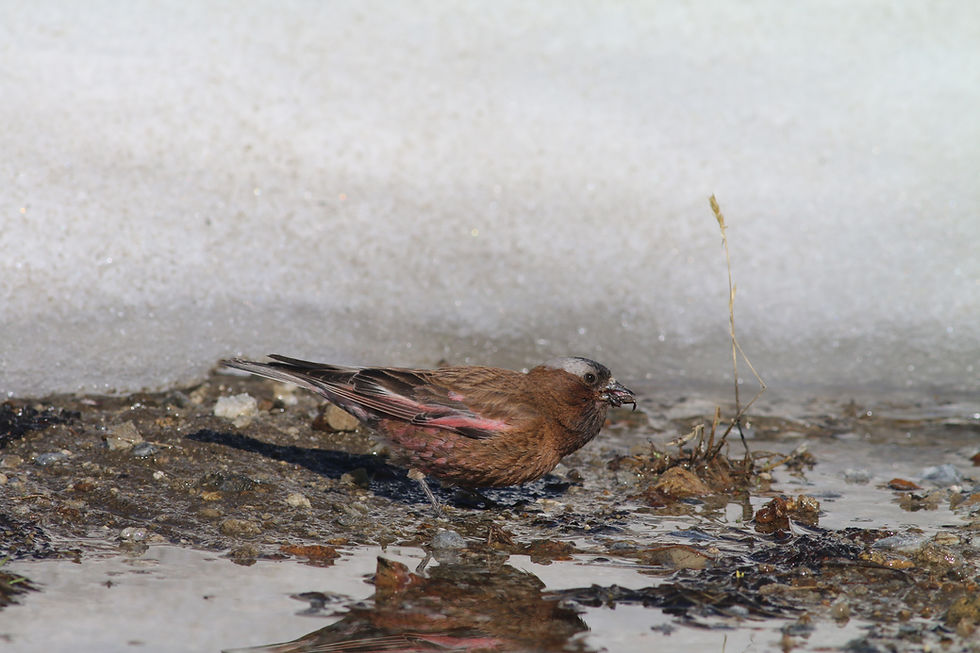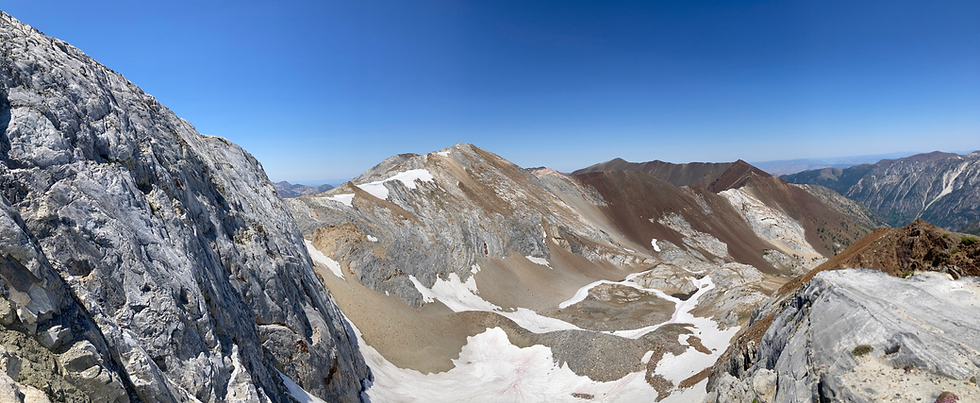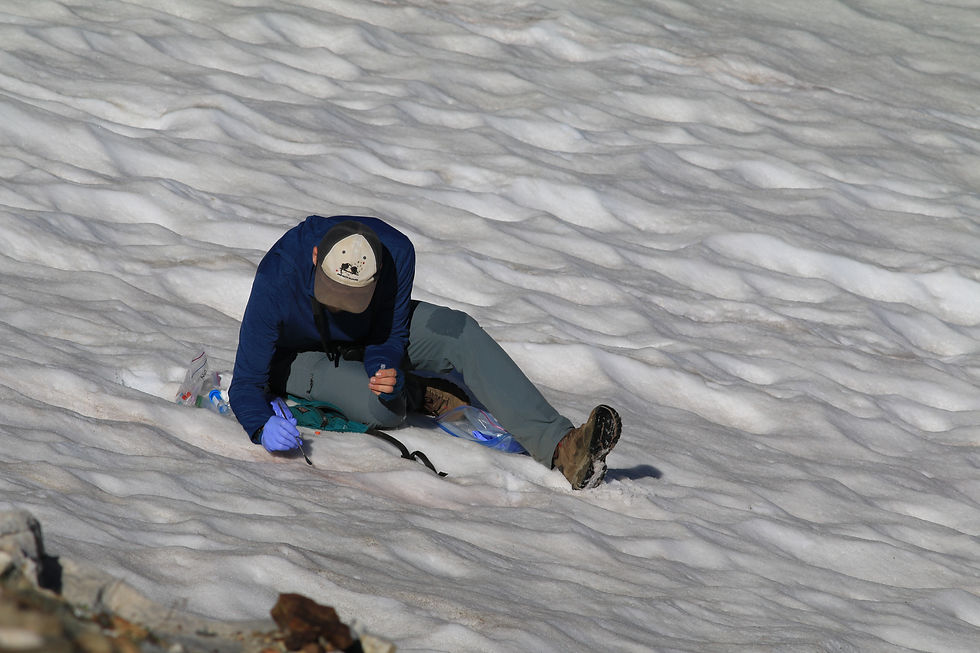The Wallowa Rosy Finch Project: Bird Monitoring in the High Country
- Nash Wadhams

- Jun 26
- 5 min read
It seems like everyone is interested in birding these days. Maybe I’m just in the “right” circles, but most of my friends - and certainly my coworkers - are at least somewhat bird-familiar. As I’m watching so many people using their phones to ID birds, I’m reminded of the Pokémon Go craze of 2016. Maybe this was mostly an urban phenomenon… People walking around outdoors, phones in hand, trying to find elusive, magical creatures to interact with. I feel that way about birding - except the creatures are real and the importance of documenting them in the landscape is undeniable.
Apps like Merlin Bird ID and eBird have opened new doors for people to engage with the natural world. With Merlin, you can take a photo or record a soundscape and receive instant identification, which feels like unlocking a secret code to the information center of the natural world. EBird allows birders to log their observations, which are then reviewed and added to a vast global database maintained by the Cornell Lab of Ornithology. Both apps lower the bar to entry, especially for those of us who haven’t mastered birding by ear, which has traditionally been only for the very skilled. Now you don't have to be an expert to get a sense of what birds are calling or singing around you. And while only eBird automatically contributes data to science, using these tools in tandem turns observations of the curious into meaningful contributions to conservation.
Though we know so much about so many birds, even massive data sets can miss certain species, especially the ones that live in places humans rarely visit or are difficult to access. For example - Two of the biggest bird monitoring efforts in North America, the National Audubon Society’s Christmas Bird Count and the North American Breeding Bird Survey, don’t include rosy finches, and more specifically, they certainly don’t include the Wallowa Rosy Finch - a special little extremophile, endemic to the Wallowa mountain range. Since 1970, waterfowl populations have increased thanks to wetland protection and restoration, while many other bird species have declined.

Let’s talk about the rosy finch. You may not be surprised to hear that all rosy finches are rosy - they all have a beautiful pink color on their wings and belly. About 30 years ago, only one species was officially recognized. Today, ornithologists classify three distinct species in North America: the Gray-crowned Rosy Finch, the Black Rosy Finch, and the Brown-capped Rosy Finch. Within the Gray-crowned Rosy Finch family alone, there are six recognized subspecies. One of the least understood is the Wallowa Rosy Finch. These birds nest in the highest reaches of Oregon’s Wallowa Mountains - areas that stay snow-covered late into the summer and are often inaccessible to people. They live in harsh, high-elevation ecosystems with cold winds, rocky slopes, and very little cover. And they’ve evolved in some very cool ways to survive.
The Wallowa Rosy Finch has a sublingual pouch - a small pocket under the tongue where they store bugs to feed their young, which they develop during the breeding season. They also seem to employ a location-specific foraging strategy, hopping along the receding edges of snowfields, picking off germinating seeds and feeding on lowland insects that get swept upslope and get stuck on the snow. Tiny, tough, and specialized, they’ve carved out a life in a very harsh environment. And they’re doing it in a special place most of us never see.

Back in May, I spoke with Dr. Ben Vernasco, who knows a lot about this special bird. Ben is a research scientist and adjunct assistant professor at Whitman College, where he leads a project to better understand the Wallowa Rosy Finch. GHCC was curious to learn how we could contribute, perhaps through community science efforts or by encouraging observations through platforms like eBird or Merlin Bird ID.
Ben grew up in the outdoors and developed a lasting appreciation for wildlife and conservation. His PhD research took him deep into the Amazon rainforest, but he told me that the fieldwork conditions he faced while conducting rosy finch research in the Wallowas were much tougher. Swarms of mosquitoes, unpredictable alpine weather, and long hikes up unforgiving ridgelines, just to maybe catch a glimpse of a rosy finch.
Rosy finches are considered a species of conservation concern by the US Forest Service, but we still know very little about them. Through his work, Ben has found signs of population isolation and possible inbreeding in the Wallowa subspecies. DNA extracted from fecal samples has been used to characterize the breeding season diet of multiple rosy finch populations. These details help fill in the gaps in our understanding, provide baseline data for future comparisons, and could help influence future conservation action.

One of the biggest mysteries about the Wallowa Rosy Finch is: Where do they winter? They're considered short-distance migrants, but no one knows exactly where they go between October and April. Unlike some more-studied birds, we don’t have migration maps, satellite tracking data, or reliable winter range observations. That’s a huge hole in our understanding, especially since a bird’s survival can often hinge more on what happens during migration and winter than the breeding season alone.
Here’s where habitat becomes critical. These birds rely on snowfields to raise their young and find food. As climate change reduces permanent snowpack in the Wallowas, we risk losing the resources these birds depend on. In New Mexico, some alpine bird populations are already disappearing. Could the same happen here? We don’t know for sure, but we’d like to find out.

High alpine ecosystems are rare and make up just 3% of global land area, but they’re packed with unique species that evolved under intense conditions. When we talk about the Wallowa Rosy Finch, we’re also thinking about other alpine-adapted species: small mammals, mountain goats, even birds like Prairie Falcons that move up and down the elevation gradient. They all rely, in some way, on intact alpine environments.
Can you see a Wallowa Rosy Finch? How can you help? Keep an eye out for this special bird! If you're hiking in the Wallowas in June or July, look near permanent snowfields and rocky cliffs. You could catch a glimpse of a rosy finch. If you do, submit your sighting to eBird or reach out to Ben and his team here: Ben Vernasco and the Wallowa Rosy Finch Project.
Second, support research and organizations that prioritize alpine conservation. Continued monitoring, especially of migration and wintering behavior, is key to protecting these birds into the future. Groups like the Mazamas, Idaho Conservation League, The Wilderness Society, and Greater Hells Canyon Council (that’s us!) work to protect these fragile ecosystems and the species that depend on them.













Comments